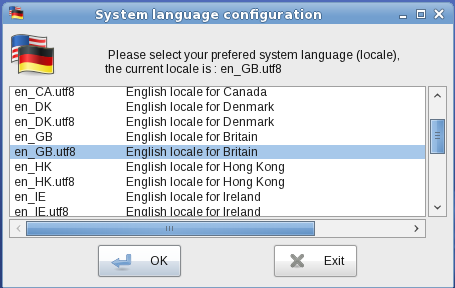
The command localeconfig allows the user to select the locale of his system. A 'locale' is a set of conventions linked to the user's language, his environment and/or his cultural conventions (like monetary symbols, date display, ...etc.). This locale is then applied to the user's working environment. By default, a Linux system is configured with the "en_US" locale, so other locales have to be specified manually ("en_GB" for the United Kingdom, "es_ES" for Spain, and so on).
You can fire up "localeconfig" from within your graphical environment (System language configuration) on Control Panel, but also in the terminal, just by typing localeconfig as root.
To set your system's locale, do the following:
Pick the language you want:

The "locale" choice is essential; a modern system will use UTF-8
instead of ISO. Don’t worry, the € symbol comes with UTF-8 also. Once
you’ve taken your pick, simply click OK.